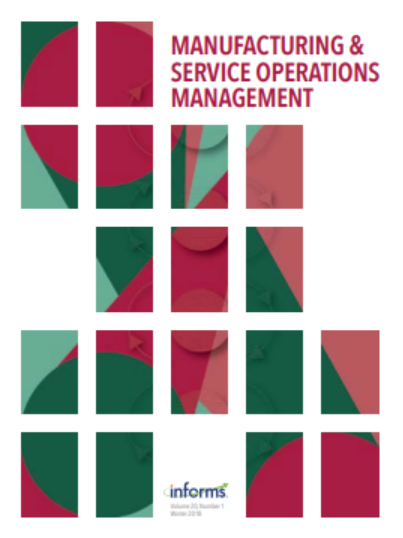The Winner’s Curse in Dynamic Forecasting of Auction Data: Empirical Evidence from eBay
IF 4.8
3区 管理学
Q1 MANAGEMENT
M&som-Manufacturing & Service Operations Management
Pub Date : 2023-05-01
DOI:10.1287/msom.2022.1165
引用次数: 2
Abstract
Problem definition: Dynamic forecasting models in auctions have fallen short on two dimensions: (i) the lack of an equilibrium model for final bids and (ii) the lack of a winner’s curse (i.e., a tendency to overpay conditional on winning the auction) adjustment to allow bidders to account for a common value component in the auction item. In this paper, we develop a methodology to accurately predict equilibrium stage bids from the initial bidding dynamics and quantify the impact of the winner’s curse. This methodology allows us to conduct policy simulations to optimize auction design parameters. Methodology/Results: Dynamic auctions typically have a stage of high exploratory activity, followed by an inactivity period, and then an equilibrium stage of last-minute bids with sharp jumps. With a Kalman filter approach, we use exploratory stage bids to predict an auction item’s valuation distribution. We feed this prediction into an equilibrium model and apply item-specific adjustments for winner’s curse, bidder heterogeneity, and inactivity period. We use the resulting equilibrium model to predict the equilibrium stage bids. Our methodology improves the forecast of equilibrium stage bids by 11.33%, on average, compared with a state-of-the-art benchmark. This improvement is even higher (18.99%) for common value auctions. We also find that (i) significantly more (respectively, fewer) bidders internalize the winner’s curse in common value (respectively, private value) auctions; (ii) bidders in common value auctions decrease their bids by 6.03% because of the winner’s curse; and (iii) the inactivity period has a lesser impact on the equilibrium stage bids in private value auctions. Managerial implications: Our proposed methodology is intended to facilitate the need in academia and practice for real-time bid predictions that encompass different levels of the common value component in auctions. Using our methodology, auction platforms can support their choice of minimum bid increment policies and decide how to allocate resources across different auctions to mitigate the adverse effects of the winner’s curse. Supplemental Material: The online appendix is available at https://doi.org/10.1287/msom.2022.1165 .拍卖数据动态预测中的赢家诅咒:来自eBay的经验证据
问题定义:拍卖中的动态预测模型在两个方面存在不足:(i)缺乏最终出价的均衡模型;(ii)缺乏赢家诅咒(即,以赢得拍卖为条件的过高支付倾向)调整,以允许竞标者考虑拍卖项目中的共同价值组成部分。在本文中,我们开发了一种从初始投标动态中准确预测均衡阶段投标的方法,并量化了赢家诅咒的影响。这种方法允许我们进行政策模拟,以优化拍卖设计参数。方法/结果:动态拍卖通常有一个高度探索性活动的阶段,随后是一个不活跃的阶段,然后是最后一刻出价急剧上升的平衡阶段。使用卡尔曼滤波方法,我们使用探索性阶段出价来预测拍卖项目的估值分布。我们将这一预测输入到一个均衡模型中,并针对赢家的诅咒、投标人的异质性和不活跃期应用特定项目的调整。我们使用得到的均衡模型来预测均衡阶段的出价。与最先进的基准相比,我们的方法平均将平衡阶段出价的预测提高了11.33%。对于普通价值拍卖,这一改进甚至更高(18.99%)。我们还发现(i)在共同价值(分别是私人价值)拍卖中,更多(分别是更少)的竞标者将赢家的诅咒内在化;(ii)由于中标人的诅咒,共同价值拍卖中的竞标人降低了6.03%的出价;(3)不活跃期对私人价值拍卖中均衡阶段出价的影响较小。管理意义:我们提出的方法旨在促进学术界和实践中对实时出价预测的需求,这些预测包括拍卖中不同水平的共同价值组成部分。使用我们的方法,拍卖平台可以支持他们选择的最低出价增量政策,并决定如何在不同的拍卖中分配资源,以减轻赢家诅咒的不利影响。补充材料:在线附录可在https://doi.org/10.1287/msom.2022.1165上获得。
本文章由计算机程序翻译,如有差异,请以英文原文为准。
求助全文
约1分钟内获得全文
求助全文
来源期刊

M&som-Manufacturing & Service Operations Management
管理科学-运筹学与管理科学
CiteScore
9.30
自引率
12.70%
发文量
184
审稿时长
12 months
期刊介绍:
M&SOM is the INFORMS journal for operations management. The purpose of the journal is to publish high-impact manuscripts that report relevant research on important problems in operations management (OM). The field of OM is the study of the innovative or traditional processes for the design, procurement, production, delivery, and recovery of goods and services. OM research entails the control, planning, design, and improvement of these processes. This research can be prescriptive, descriptive, or predictive; however, the intent of the research is ultimately to develop some form of enduring knowledge that can lead to more efficient or effective processes for the creation and delivery of goods and services.
M&SOM encourages a variety of methodological approaches to OM research; papers may be theoretical or empirical, analytical or computational, and may be based on a range of established research disciplines. M&SOM encourages contributions in OM across the full spectrum of decision making: strategic, tactical, and operational. Furthermore, the journal supports research that examines pertinent issues at the interfaces between OM and other functional areas.
 求助内容:
求助内容: 应助结果提醒方式:
应助结果提醒方式:


